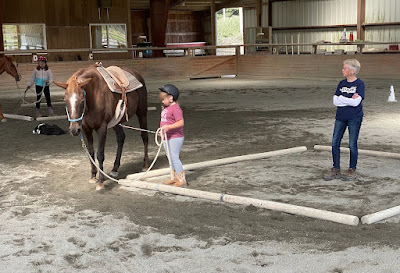by Mary Gallagher
 Astute observation by many horsemen over the years has clarified the horse’s need for the herd as a place to feel safe in an uncontrolled environment. As a trainer for many years, I have come to understand and respect what a huge part ‘uncontrolled environment’ plays in their learning ability. Simply put, horses learn better if they feel safe, and the environment is key. So within the environment ‘out there’ beyond our work space, I need to:
Astute observation by many horsemen over the years has clarified the horse’s need for the herd as a place to feel safe in an uncontrolled environment. As a trainer for many years, I have come to understand and respect what a huge part ‘uncontrolled environment’ plays in their learning ability. Simply put, horses learn better if they feel safe, and the environment is key. So within the environment ‘out there’ beyond our work space, I need to: 1) establish a safe environment in which to cultivate leadership and healthy boundaries, and
2) establish my place in our herd hierarchy of two by doing so.
The more competent the leadership, the less threatening the environment; the safer the environment, the more opportunities for learning.
If we lack awareness of the importance of the environment and the horse’s need for our leadership, we can easily cause the horse to lose confidence in us and worse, trigger their survival instinct. They run when they feel in danger, and when trapped they will fight uncontrollably to get free. Or they may, after deciding we are not in charge, begin to push us or otherwise get in our space to assert dominance, e.g. control of our ‘herd of two’. In short, we can quickly find ourselves in trouble when we forget the horse’s perspective on the environment—a place of potential threat at any moment. Most humans in the developed world have lost the habit of continual surveillance of our surroundings, while for the horse, it’s 24/7.
So the deeper basis for our leadership is awareness of the environment and the horse’s response to it, continuous observation of the horse as we have him move, and effective responses to his behavior. A big help in that department is setting and maintaining boundaries.
To start, I train in the environment the horse feels the most safe in, such as a small round pen, and only venture out as any boundaries I’ve set hold up. This doesn’t mean my horse is never to venture out of the safe places. After a certain amount of work together, as I carefully venture out of the safe place we are working, I observe: does my boundary hold up? If my boundary—the foundation of our working safely—does not hold up, I’ll go back to where it does work, and then work up to a level where my horse trusts that I am a safe leader.
What constitutes a boundary? Something that separates the horse from myself; a barrier the horse respects at all times. In a small pen, poles and cones are handy for marking space and suggesting boundaries. In a larger space, Cavaletti poles in a box shape—which I call The Boundary Box— is a favorite of mine. Halter rope and stick/string/flag, barrels, poles, and other obstacles are also familiar to most of us and with proper use, create and/or support safe boundaries.
But these by themselves do not constitute effective boundaries or safety. It is our observation skills and ability to respond effectively which make them truly boundaries.
Last year I devoted a blog post to my favorite dictum, “Observe, observe, observe!” and suggested various behaviors indicating the horse’s levels of concern. Here I want to share the beginnings of a handy tool for making sense of what we see.
You’ll notice that to either side there is danger: on the left, the danger of dominance as the horse seeks to control the situation, and opposite on the right, the danger of fear as the horse checks out in an adrenaline surge of fight/flight.
The stabilizing factor in either direction is boundaries, created by physical objects, or tools and techniques wisely applied, as I mentioned above.
In my next article, I will introduce a more complete diagram, helpful for developing our ability to identify and troubleshoot what we observe in the horse at any moment. It’s a time-tested framework I’ve developed over many years with thousands of horses. In the meantime, here are a few examples of working with the Boundary box:
 |
| Helping a student step in time with the horse... |
 |
| Even the youngest riders can learn boundaries. |
In summary, when we understand the importance of environment, we will naturally do our most difficult work in the safest environment. Allow curiosity and relaxation to be the horses motivation to venture out of the safe environment, not force.
In this manner, we would grow our safe environment quicker because we allowed relaxation from our focused work to be on the edges of the safe environment. Horses understand release of pressure, and when we can time that release effectively, the horse will find confidence in our leadership and the safe environment will expand.
Our leadership is developed through consistent and effective management of boundaries. These boundaries are best established when the horse is in a learning space, not a space that triggers the fight or flight response.
So, with a diagram for understanding environment and behavior in mind, tools like a boundary box or round pen in the proper environment can truly help us in establishing and reinforcing boundaries and developing the language of leadership.


Thanks so much for clarifying this issue - I love the diagram of the learning/safety zone and how it relates to either fear or dominance.
ReplyDelete